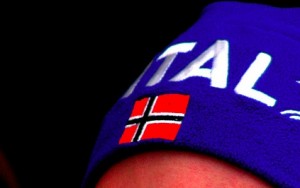What’s in a flag? Posted by Bjørn A. Bojesen on Jan 30, 2014 in Norway and the world, Traditions

The Norwegian flag has become a global symbol for cool winter wear. (Based on phunkstarr’s photo at http://www.flickr.com/photos/jonmelsa/2897039322/sizes/m/, released under the Creative Commons license: http://creativecommons.org/licenses/by/2.0/)
Det er Norge i rødt, hvitt og blått! That’s Norway in red, white and blue! So many Norwegians sing on 17. mai, Norges nasjonaldag. As the text shows, Norwegians love their flagg. On festive occassions, such as skirenn (ski races) and bursdager (birthdays), they’ll fetch their little handheld fabric flags and wave them energetically. Recently, several clothing companies have adopted the Norwegian flag as a symbol of everything cool & Nordic – I see Norwegian flags all the time on vinterjakker (winter coats) in Denmark, where I currently live.
Like the flags of the other Nordic countries – Sverige (Sweden), Danmark, Finland, Island (Iceland), Færøyene (The Faroe Islands) and Åland – the Norwegian one is a korsflagg (cross flag). The cross shows that kristendommen (Christianity) is the dominant faith in Norway.
Throughout history, Norway has had a complicated relationship to its neighbours. For some 400 years, the country was the underdog in a union with Denmark. Hence, the ancient Danish red and white flag was flown in every Norwegian village and town. In 1814, Norway left the union with Denmark, only to enter a new union with Sweden (which lasted until 1905, when Norway finally ceased to be ”the weaker part” and became fully independent – as it had been in the Viking Ages). Within the Norwegian-Swedish union, there arose a need for a specific Norwegian flag. According to Wikipedia, it was the politician Frederik Meltzer who designed the modern Norwegian flag in 1821. Meltzer combined the red and white of the Danish flag (which, after all, had been the flag of Norwegians for four centuries) with the blue of the Swedish flag. As in the Danish flag, the two rectangles closest to the pole are square (in the Swedish and Finnish flags, they’re oblong). From 1844 to 1898 both the Norwegian and the Swedish flag carried a ”union sign” in the upper rectangle, next to the pole. This sign, combining the flags of Norway and Sweden, was known as ”sildesalaten” (the herring salad).Even though Meltzer was inspired by the neighbouring flags, his design was clearly unique. Never before had a Nordic flag carried ”a cross within a cross”. (An idea that was later copied by Iceland, the Faroe Island and Åland.) The red and blue colours of the Norwegian flag are also noticeably darker than those of its Danish and Swedish counterparts. The Norwegian flag is, indeed, its own. I for one think it’s quite beautiful, when it’s fluttering next to a wooden village church or from the stern of a boat between snow-clad mountains.
Many people have also linked the colours of the Norwegian flag with those of the French and American flags. After the revolutions in France and the US, those countries became ideals for freedom-loving peoples everywhere, including the Norwegians.

Build vocabulary, practice pronunciation, and more with Transparent Language Online. Available anytime, anywhere, on any device.
About the Author: Bjørn A. Bojesen
I was born in Denmark, but spent large parts of my childhood and study years in Norway. I later returned to Denmark, where I finished my MA in Scandinavian Studies. Having relatives in Sweden as well, I feel very Scandinavian! I enjoy reading and travelling, and sharing stories with you! You’re always welcome to share your thoughts with me and the other readers.






